2018 MITSUBISHI OUTLANDER III belt
[x] Cancel search: beltPage 70 of 441

Supplemental Restraint System (SRS) - airbag
Seat and restraint systems 4-41
4
The system senses that a child is using achild restraint system
on the front passen-
ger’s seat.
When the passenger’s se
at occupant classifi-
cation sensor system sense there is a personseated in the front passenger’s seat, the indi-cator goes out to show that the passenger’sfront airbag is operational.
N00408301589
There is a Supplemen
tal Restraint System
(SRS) warning light on the instrument panel.The system checks itself every time the igni-tion switch is turned to the “ON” position orthe operation mode is put in ON. The SRSwarning light will come on for several sec-
onds and then go out. This is normal andmeans the system is working properly.If there is a problem
involving one or more of
the SRS components, the warning light willcome on and stay on. At
the same time, the
warning display will appear on the informa-tion screen in the multi information display(Type 1 only).The SRS warning light/display is shared bythe SRS airbag and the se
at belt pre-tensioner
system.
WA R N I N GIf any of the following conditions occur,you should immediat
ely have the airbag
system in your vehicle inspected by anauthorized Mitsubishi
Motors dealer as
soon as possible:• The passenger’s airbag off indicatorcomes on when an adul
t is sitting on the
front passenger seat.• The passenger’s airbag off indicator doesnot come on when the front passengerseat is not occupied.• The passenger’s airbag off indicator doesnot come on when the ignition switch isturned to the “ON” position or the oper-ation mode is put in ON.• The passenger’s airbag off indicator doesnot come on when a
child is in a child
restraint system on the front passenger’sseat.• The passenger’s airbag off indicatorcomes on and goes out repeatedly.
Do not attach any accessory to your vehi-cle that makes the passenger’s airbag offindicator difficult or
impossible to see.
You must be able to see the passenger’sairbag off indicator an
d verify the status
of the passenger’s airbag system.
SRS warning light/display
WA R N I N G
Type 1Type 2
WA R N I N GIf any of the following conditions occur,there may be a problem with the SRS air-bags and/or seat belt
pre-tensioners, and
they may not function
properly in a colli-
sion or may suddenly
activate without a
collision:•Even when the igniti
on switch or the
operation mode is in ON, the SRS warn-ing light does not come on or it remainson.• The SRS warning light and/or the warn-ing display comes
on while driving.
The SRS airbags and
seat belt pre-ten-
sioners are designed to help reduce therisk of serious injury
or death in certain
collisions. If either of the above conditionsoccurs, immediately
have your vehicle
checked by an auth
orized Mitsubishi
Motors dealer.
BK0249100US.book 41 ページ 2017年5月10日 水曜日 午前8時49分
Page 72 of 441
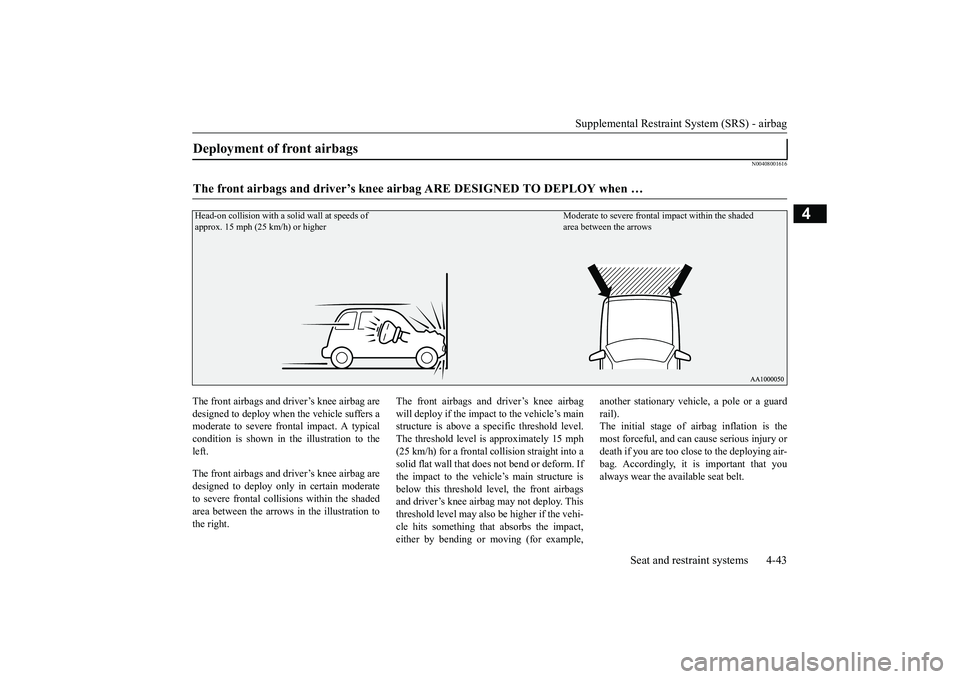
Supplemental Restraint System (SRS) - airbag
Seat and restraint systems 4-43
4
N00408001616
The front airbags and driver’s knee airbag aredesigned to deploy when
the vehicle suffers a
moderate to severe fro
ntal impact. A typical
condition is shown in th
e illustration to the
left.The front airbags and driver’s knee airbag aredesigned to deploy only in certain moderateto severe frontal collisions within the shadedarea between the arrows in the illustration tothe right.
The front airbags and driver’s knee airbagwill deploy if the impact to the vehicle’s mainstructure is above a sp
ecific threshold level.
The threshold level is
approximately 15 mph
(25 km/h) for a frontal collision straight into asolid flat wall that does not bend or deform. Ifthe impact to the vehicle’s main structure isbelow this threshold le
vel, the front airbags
and driver’s knee airbag may not deploy. Thisthreshold level may also
be higher if the vehi-
cle hits something that absorbs the impact,either by bending or moving (for example,
another stationary vehi
cle, a pole or a guard
rail).The initial stage of airbag inflation is themost forceful, and can
cause serious injury or
death if you are too clos
e to the deploying air-
bag. Accordingly, it
is important that you
always wear the available seat belt.
Deployment of front airbags The front airbags and driver’s knee airb
ag ARE DESIGNED TO DEPLOY when …
approx. 15 mph (25 km/h) or higher
Moderate to severe frontal
impact within the shaded
area between the arrows
BK0249100US.book 43 ページ 2017年5月10日 水曜日 午前8時49分
Page 73 of 441
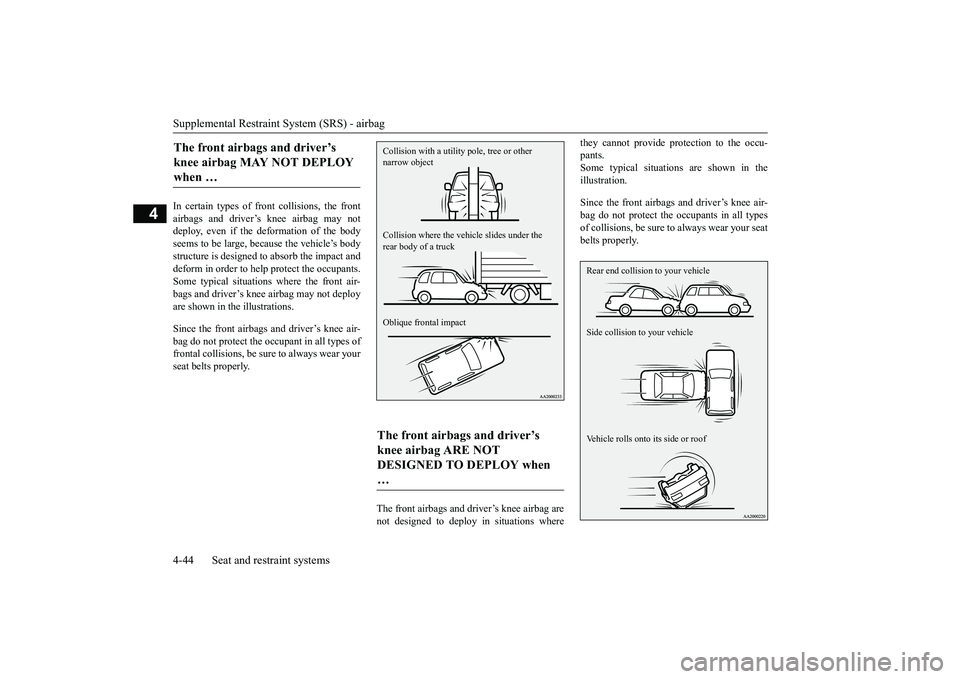
Supplemental Restraint System (SRS) - airbag4-44 Seat and restraint systems
4
In certain types of front collisions, the frontairbags and driver’s knee airbag may notdeploy, even if the deformation of the bodyseems to be large, because the vehicle’s bodystructure is designed to
absorb the impact and
deform in order to help
protect the occupants.
Some typical situations where the front air-bags and driver’s knee airbag may not deployare shown in the illustrations.Since the front airbags and driver’s knee air-bag do not protect the oc
cupant in all types of
frontal collisions, be su
re to always wear your
seat belts properly.
The front airbags and driver’s knee airbag arenot designed to deploy in situations where
they cannot provide protection to the occu-pants.Some typical situations are shown in theillustration.Since the front airbags and driver’s knee air-bag do not protect the oc
cupants in all types
of collisions, be sure
to always wear your seat
belts properly.
The front airbags and driver’s knee airbag MAY NOT DEPLOY when …
The front airbags and driver’s knee airbag ARE NOT DESIGNED TO DEPLOY when … Collision with a utility pole, tree or other narrow objectCollision where the vehi
cle slides under the
rear body of a truckOblique frontal impact
Rear end collision to your vehicleSide collision to your vehicleVehicle rolls onto its side or roof
BK0249100US.book 44 ページ 2017年5月10日 水曜日 午前8時49分
Page 74 of 441
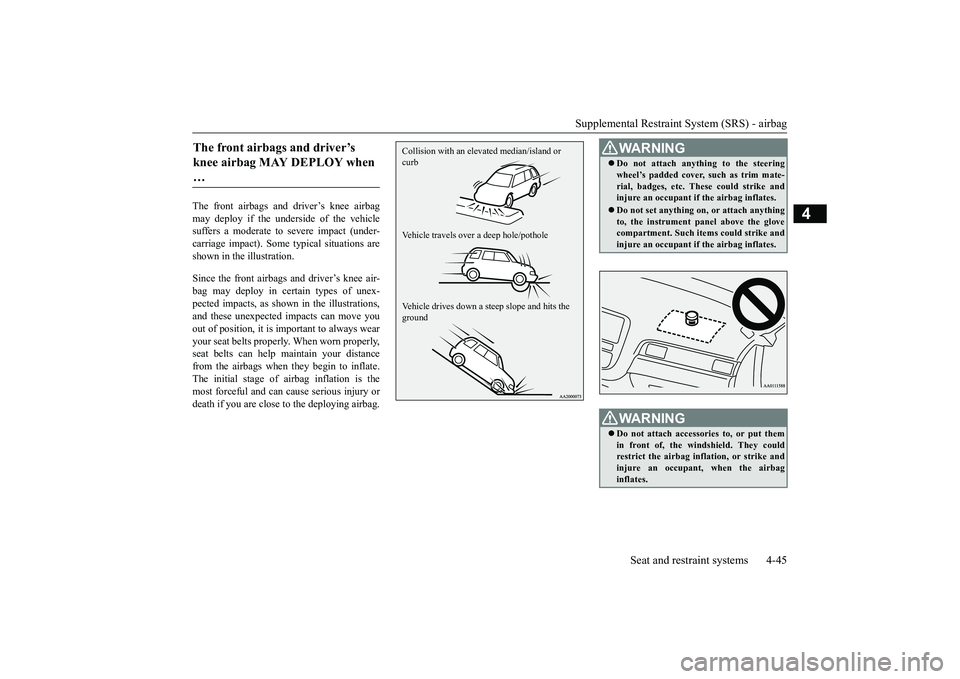
Supplemental Restraint System (SRS) - airbag
Seat and restraint systems 4-45
4
The front airbags and driver’s knee airbagmay deploy if the underside of the vehiclesuffers a moderate to
severe impact (under-
carriage impact). Some typical situations areshown in the illustration.Since the front airbags and driver’s knee air-bag may deploy in ce
rtain types of unex-
pected impacts, as show
n in the illustrations,
and these unexpected impacts can move youout of position, it is
important to always wear
your seat belts properly. When worn properly,seat belts can help maintain your distancefrom the airbags when they begin to inflate.The initial stage of airbag inflation is themost forceful and can cause serious injury ordeath if you are close to the deploying airbag.The front airbags and driver’s knee airbag MAY DEPLOY when …
Collision with an elevat
ed median/island or
curbVehicle travels over a deep hole/potholeVehicle drives down a steep slope and hits the ground
WA R N I N GDo not attach anything to the steeringwheel’s padded cover, such as trim mate-rial, badges, etc. These could strike andinjure an occupant if
the airbag inflates.
Do not set anything on, or attach anythingto, the instrument
panel above the glove
compartment. Such items could strike andinjure an occupant if
the airbag inflates.
WA R N I N GDo not attach accessories to, or put themin front of, the wind
shield. They could
restrict the airbag infl
ation, or strike and
injure an occupant, when the airbaginflates.
BK0249100US.book 45 ページ 2017年5月10日 水曜日 午前8時49分
Page 78 of 441
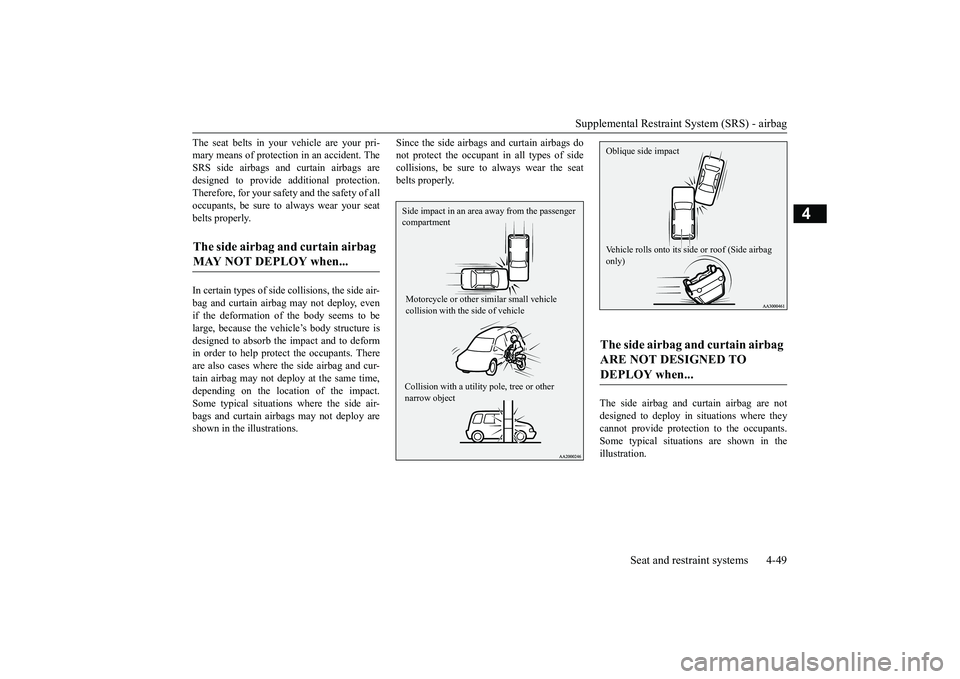
Supplemental Restraint System (SRS) - airbag
Seat and restraint systems 4-49
4
The seat belts in your
vehicle are your pri-
mary means of protection in an accident. TheSRS side airbags and curtain airbags aredesigned to provide
additional protection.
Therefore, for your safety and the safety of alloccupants, be sure to always wear your seatbelts properly.In certain types of side
collisions, the side air-
bag and curtain airbag
may not deploy, even
if the deformation of the body seems to belarge, because the vehicle’s body structure isdesigned to absorb the impact and to deformin order to help protect the occupants. Thereare also cases where the side airbag and cur-tain airbag may not deploy at the same time,depending on the location of the impact.Some typical situations
where the side air-
bags and curtain airb
ags may not deploy are
shown in the illustrations.
Since the side airbags and curtain airbags donot protect the occupant in all types of sidecollisions, be sure to
always wear the seat
belts properly.
The side airbag and curtain airbag are notdesigned to deploy in situations where theycannot provide protec
tion to the occupants.
Some typical situations are shown in theillustration.
The side airbag and curtain airbag MAY NOT DEPLOY when...
Side impact in an area away from the passenger compartmentMotorcycle or other similar small vehicle collision with the side of vehicleCollision with a utility pole, tree or other narrow object
The side airbag and curtain airbag ARE NOT DESIGNED TO DEPLOY when... Oblique side impactVehicle rolls onto its side or roof (Side airbag only)
BK0249100US.book 49 ページ 2017年5月10日 水曜日 午前8時49分
Page 79 of 441
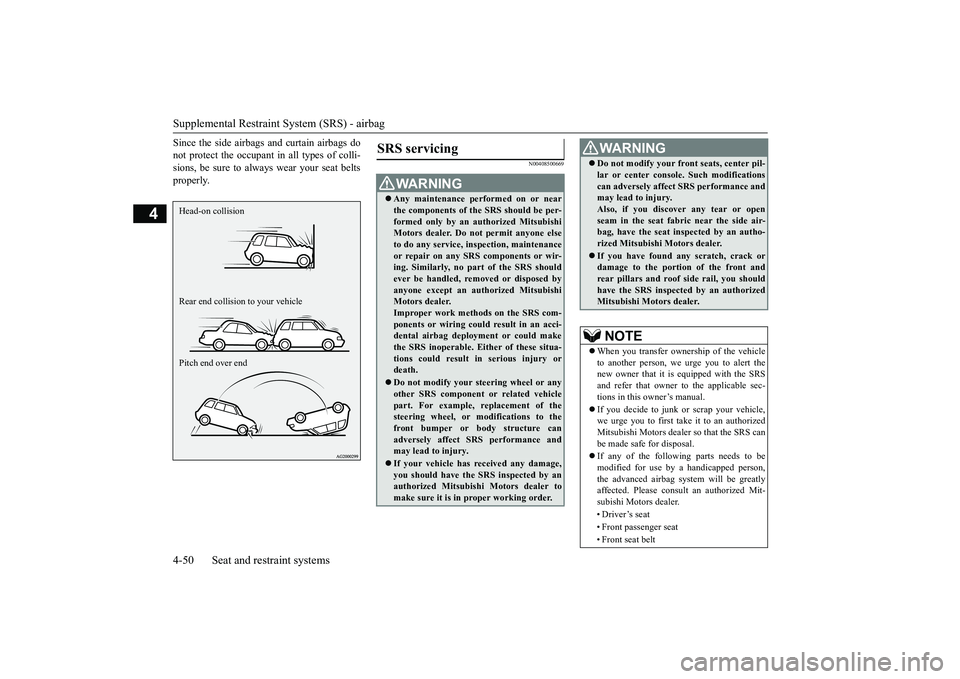
Supplemental Restraint System (SRS) - airbag4-50 Seat and restraint systems
4
Since the side airbags and curtain airbags donot protect the occupant
in all types of colli-
sions, be sure to always
wear your seat belts
properly.
N00408500669
Head-on collisionRear end collision to your vehiclePitch end over end
SRS servicing
WA R N I N GAny maintenance performed on or nearthe components of the SRS should be per-formed only by an
authorized Mitsubishi
Motors dealer. Do not permit anyone elseto do any service, inspection, maintenanceor repair on any SR
S components or wir-
ing. Similarly, no part of the SRS shouldever be handled, removed or disposed byanyone except an au
thorized Mitsubishi
Motors dealer.Improper work meth
ods on the SRS com-
ponents or wiring could result in an acci-dental airbag deployment or could makethe SRS inoperable. Ei
ther of these situa-
tions could result in serious injury ordeath.Do not modify your steering wheel or anyother SRS component or related vehiclepart. For example, replacement of thesteering wheel, or modifications to thefront bumper or body structure canadversely affect SR
S performance and
may lead to injury.If your vehicle has received any damage,you should have the
SRS inspected by an
authorized Mitsubishi
Motors dealer to
make sure it is in proper working order.
Do not modify your front seats, center pil-lar or center console. Such modificationscan adversely affect
SRS performance and
may lead to injury.Also, if you discove
r any tear or open
seam in the seat fabr
ic near the side air-
bag, have the seat in
spected by an autho-
rized Mitsubishi Motors dealer.If you have found an
y scratch, crack or
damage to the portion of the front andrear pillars and roof
side rail, you should
have the SRS inspected by an authorizedMitsubishi Motors dealer.NOTE
When you transfer ownership of the vehicleto another person, we
urge you to alert the
new owner that it is
equipped with the SRS
and refer that owner to the applicable sec-tions in this owner’s manual.If you decide to junk or
scrap your vehicle,
we urge you to first take it to an authorizedMitsubishi Motors dealer so that the SRS canbe made safe for disposal.If any of the following parts needs to bemodified for use by a handicapped person,the advanced airbag system will be greatlyaffected. Please consult an authorized Mit-subishi Motors dealer.• Driver’s seat• Front passenger seat• Front seat beltWA R N I N G
BK0249100US.book 50 ページ 2017年5月10日 水曜日 午前8時49分
Page 106 of 441

Free-hand Advanced Securi
ty Transmitter (F.A.S.T.-key) (if so equipped)
Features and controls 5-25
5
N00514601399
The operation mode can be in any modeto start the engine.The starter motor will be turning for up toapproximately 15 seconds if the engineswitch is released at once. Pressing theengine switch again while the startermotor is still turning will stop the startermotor.The starter motor will be turning for up toapproximately 30 seconds while theengine switch
is pressed.
If the engine does not start, wait for awhile and then attempt to start the engineagain. Trying repeatedly with the engineor starter motor still turning will damagethe starter mechanism.If the engine will not start because the bat-tery is weak or discharged, refer to“Jump-starting the engine” on page 8-2for instructions.A longer warm up period will only con-sume extra fuel.The engine is warmed up enough for driv-ing when the bar graph of engine coolanttemperature display starts to move or thelow coolant temperature indicator goesout. Refer to “Engine
coolant temperature
display” on page 5-161 or “Low coolanttemperature indica
tor” on page 5-202.
Your vehicle is equipped with an electroni-cally controlled fuel injection system. Thissystem automatically controls fuel injection.There is usually no need
to depress the accel-
erator pedal when starting the engine.To prevent battery drai
n, wait a few seconds
between attempts to restart the engine.1. Make sure all occupants are properlyseated with seat belts fastened.2. Make sure the parking brake is applied.3. Press and hold the brake pedal downfirmly with your right foot.4. Make sure the selector
lever is in the “P”
If there is a fault in the steering wheel lock,the warning display will
appear. Immediately
stop the vehicle in a sa
fe place and contact
an authorized Mitsubishi Motors dealer.Warning display
Starting and stopping the engine
Tips for starting
NOTE
WA R N I N GNever run the engine in
a closed or poorly
ventilated area any longer than is neededto move your vehicle
out of the area. Car-
bon monoxide gas, wh
ich is odorless and
extremely poisonous, could build up andcause serious injury or death.CAUTIONDo not push-start the vehicle.
Do not run the engine at high rpms or driveat high speeds until the engine has had achance to warm up.
Starting the engine
NOTE
After the engine has not started for a while,the brake pedal effort needed to start theengine may become grea
ter. If this occurs,
depress the brake pedal more firmly thanusual.CAUTION
BK0249100US.book 25 ページ 2017年5月10日 水曜日 午前8時49分
Page 115 of 441
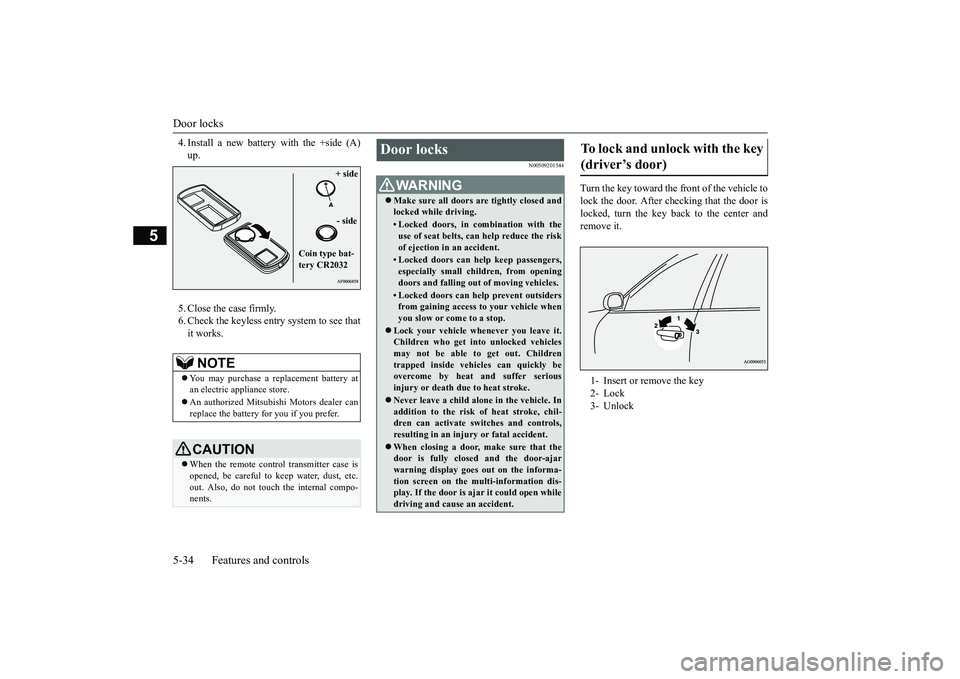
Door locks5-34 Features and controls
5
4. Install a new battery with the +side (A)5. Close the case firmly.6. Check the keyless entry system to see thatit works.
N00509201544
Turn the key toward the front of the vehicle tolock the door. After checking that the door islocked, turn the key back to the center andremove it.
NOTE
You may purchase a re
placement battery at
an electric appliance store.An authorized Mitsubishi Motors dealer canreplace the battery for you if you prefer.CAUTIONWhen the remote control transmitter case isopened, be careful to
keep water, dust, etc.
out. Also, do not touch the internal compo-nents.
+ side- side
Coin type bat-tery CR2032
Door locks
WA R N I N GMake sure all doors are tightly closed andlocked while driving.• Locked doors, in co
mbination with the
use of seat belts, can help reduce the riskof ejection in
an accident.
• Locked doors can help keep passengers,especially small children, from openingdoors and falling out
of moving vehicles.
• Locked doors can help
prevent outsiders
from gaining access to your vehicle whenyou slow or come to a stop.
Lock your vehicle when
ever you leave it.
Children who get into
unlocked vehicles
may not be able to get out. Childrentrapped inside vehicles can quickly beovercome by heat
and suffer serious
injury or death due to heat stroke.Never leave a ch
ild alone in the vehicle. In
addition to the risk
of heat stroke, chil-
dren can activate switches and controls,resulting in an injury
or fatal accident.
When closing a door,
make sure that the
door is fully closed and the door-ajarwarning display goes
out on the informa-
tion screen on the multi-information dis-play. If the door is aj
ar it could open while
driving and cause an accident.
To lock and unlock with the key (driver’s door) 1- Insert or remove the key2- Lock3- Unlock
BK0249100US.book 34 ページ 2017年5月10日 水曜日 午前8時49分